-
Car Reviews
- All reviews
- Midsize SUVs
- Small cars
- Utes
- Small SUVs
- Large SUVs
- Large cars
- Sports SUVs
- Sports cars
- Vans
Latest reviews
- Car News
-
Car Comparisons
Latest comparisons
- Chasing Deals
Sharing its platform and hard points with the previous generation BRZ, you could be fooled into thinking Subaru’s ‘new’ BRZ is merely an update. But you’d be wrong
After years of almost nothing in the affordable sports-coupe department, the first-generation Subaru BRZ (and its Toyota 86 twin) heralded a dramatic return. This wasn’t just your run-of-the-mill revival either – resuscitating the front-drive blueprint that had taken hold in the ’80s – but a genuine attempt at offering a purist sports coupe for an egalitarian price.
Now, almost a decade later, the Subaru BRZ is back for its second generation. Borrowing much from the original engineering design (including most dimensions, the body’s hard points, the FR platform underneath and the fundamental DNA of the FA-series flat four engine, as well as the transmissions), the 2022 BRZ could potentially be dismissed as little more than a light reskin with a fresh interior and a bored-out engine.
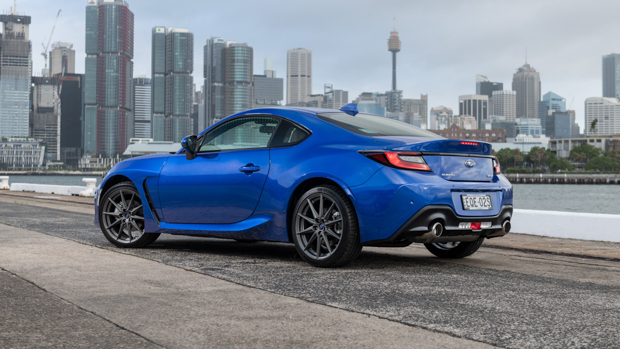
But that would be ignoring the vast amounts of detail engineering that has gone into transforming the BRZ into a more capable, more well-rounded sports coupe that has managed to grow up without growing old.
The previous BRZ already had the fundamentals sorted – its superb driving position, instinctive steering and involving handling being the highlights – but the level of finessing that has gone into improving its successor covers all areas, from active-safety features to interior presentation and tactility, and even to its appearance and functional body venting.
Yet it’s the way the BRZ drives that matters most. Does it truly lift the standard of affordable sporting coupes as much as the fan boys and girls hoped it would?
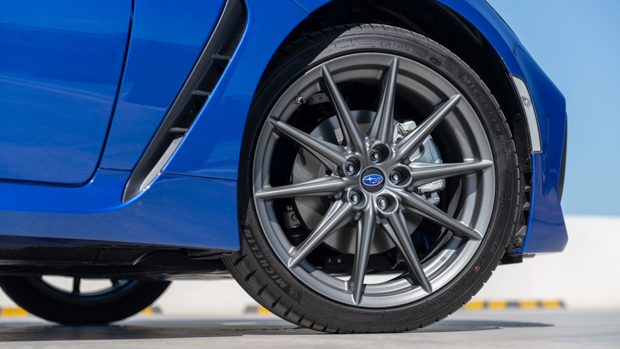
The Australian launch of the new BRZ saw us provided with a rare opportunity to drive the previous model for purposes of comparing to the new car. Given the limited road loop we were subjected to (33km of lumpy, twisty roads through properties near Sydney Motorsport Park, in conjunction with motorkhana and south-circuit driving exercises), this proved invaluable in assessing the new BRZ’s wealth of improvements.
First, the hardware. Thanks to measures such as incorporating an aluminium bonnet, front guards and roof, Subaru has lowered the BRZ’s centre of gravity by 4mm and kept its waistline relatively trim – 1286kg for the base manual, 1307kg for the base auto. Yet there’s also considerable improvements in body stiffness, with front lateral flexing rigidity increased by 60 percent and overall body torsional rigidity up 50 percent.
While the BRZ’s suspension set-up is essentially carried over, suspension mounts are stronger, rebound springs have been added to the front struts, steering-rack bushings are better supported, aluminium front wheel hubs reduce weight by 3kg each and a hollow anti-roll bar rips out 400 grams.
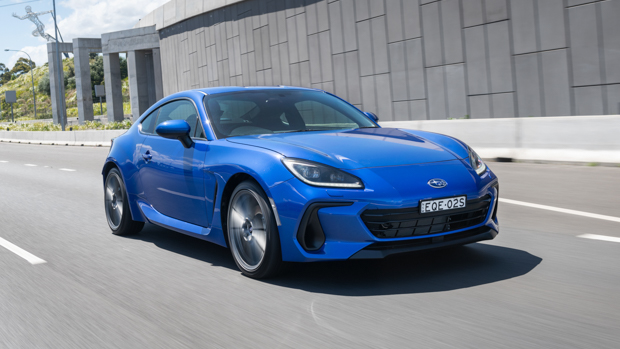
At the rear, a 10mm-wider track combines with increased subframe rigidity, revised mounting for the (1mm smaller) rear anti-roll bar (now bolted to the chassis) and firmer trailing-arm bushes to improve overall stability. And to work best with the strengthened structure and muscular new engine, all spring and damper rates have been revised.
As for the new FA24 2.4-litre direct- and port-injected flat-four: it’s a cracker. While based on the block of the previous FA20, bore diameter has grown from 86mm to 94mm, expanding capacity to 2387cc. Yet there’s also a completely revised induction system (to remove the torque ‘dip’ at mid revs), different connecting rods and larger big-end diameter, and even the engine mounts have changed – now separate from the block to reduce noise and vibration.
The result is a considerable increase in shove – 174kW at 7000rpm and 250Nm at 3700rpm – that’s instantly apparent. Throttle response is crisper, torque is way more generous and driveability characteristics are far superior. The BRZ manual will pull from 1500rpm without complaint and once there’s 2800rpm showing on the tacho, it’s a muscular gun show that grows firmer and faster right to the 7400rpm redline. For anyone who lamented the lack of herbs of the previous 2.0-litre (or the lack of a turbo), the big-bore 2.4 is welcome relief.
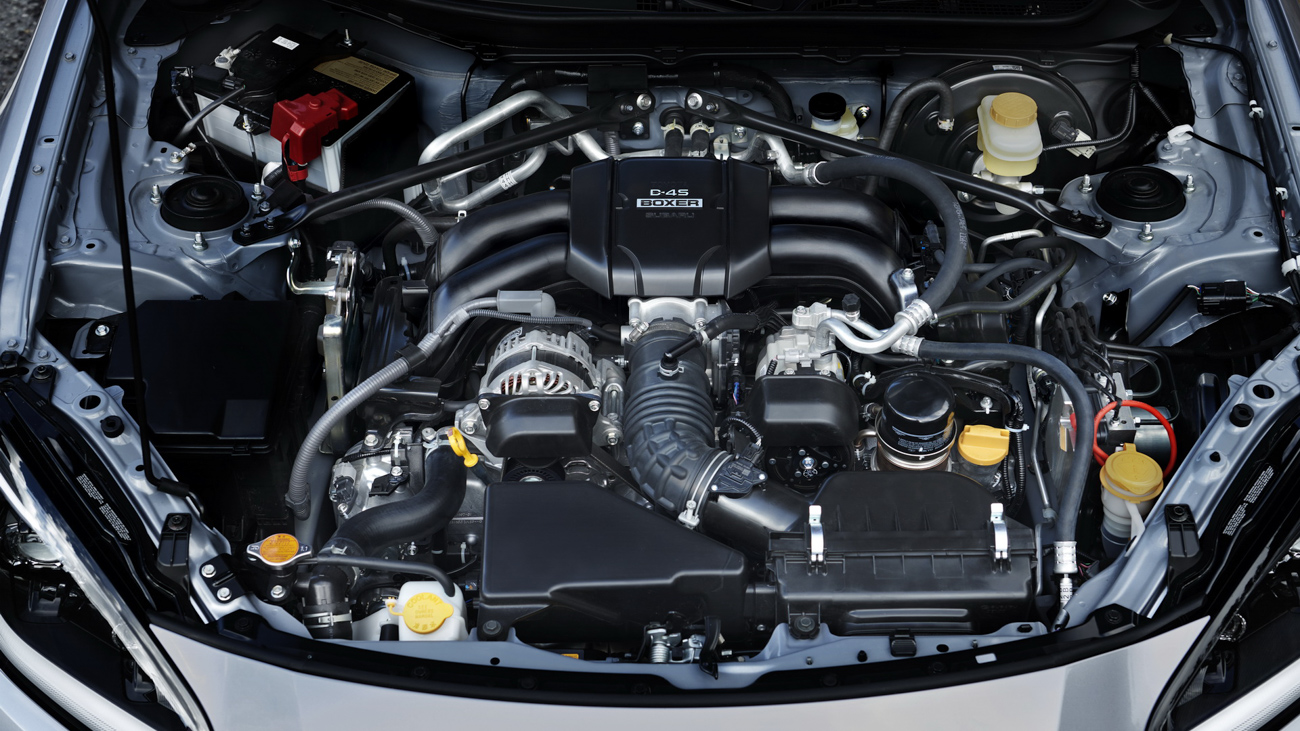
It’s smoother and more progressive as well, though I’m not entirely sold on the Active Sound Control that synthesises induction sound from a speaker behind the dashboard. Sure, it’s much less intrusive than the plenum-plumbed blare of the old FA20 but I’m just not sure it’s flat-four enough. It only really fires up when you’re hammering the BRZ (and has two mildly different sound levels depending on whether you’ve engaged ‘Track’ or not) but I wish Subaru spent more time tweaking actual hardware (like the exhaust!) than massaging silicone chips.
Both transmissions are carry-over – the TL70 six-speed manual with improved diagonal (eg. second to third) shift smoothness and the TX6A six-speed auto which has undergone significant recalibration to improve its intuitiveness. Both transfer power via a torsen limited-slip rear differential to excellent 215/40R18 Michelin Pilot Sport 4 tyres. Despite its improvements, the manual can feel a bit notchy in its upper ratios, though our test cars were very fresh. Maybe more mileage might help.
What can’t be disputed, though, is just how much sweeter the combination is of the BRZ’s beautifully finessed chassis and buxom new engine. It makes the car much more satisfying to drive at low to middling revs, and thanks to its considerable torque increase, way more rewarding when exploring its considerable dynamic talent because you don’t need to flog the engine to attain a rhythm.
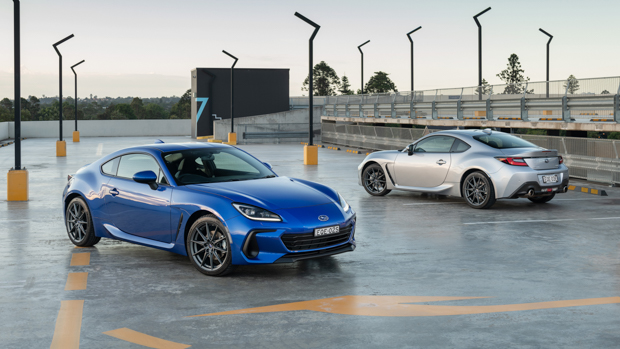
Having not tackled something like the Putty Road or a great set of curves out in the real world, I can’t give a definitive verdict on the new BRZ’s steering feel, however the smoothly progressive harmony of its steering response, handling balance, and corner-exit punch is delightful.
In comparison, the old model feels inconsistent, lacking in grip and stability, noisy rather than punchy, and slightly immature as well – it’s a 10-year-old car and feels it. And while the new BRZ’s ultimate ride quality also awaits a final verdict, what can be confirmed is that it’s entirely liveable over low-speed bumps, although the fancy Michelins drum up a fair amount of road noise over Australia’s coarse surfaces. Then again, so does a 911 Turbo…
The new-generation BRZ also transforms the active-safety offering, and now spreads most of the same features across both manual and automatic models. These include not only improved cabin visibility and a Sport ESC mode but also Subaru’s full camera-based ‘EyeSight’ driver-assist system with front AEB, pre-collision throttle management, adaptive cruise control, lead vehicle departure alert, lane-departure warning, lane-sway warning, blind-spot monitoring, lane-change assist, rear cross-traffic alert, and on automatic BRZs, rear AEB.
Despite various (justified) grievances aimed at the previous BRZ’s rubbish infotainment system and inexpensive plastics, you couldn’t argue against the basics. In terms of driving position, front seat comfort and general ergonomics, it was superb.
Given the negligible dimensional differences between the two generations (5mm-longer wheelbase, 25mm length increase and 15mm height reduction), all the new-gen BRZ needed to do was fill in the gaps, and that’s exactly what has happened. The driving position, front seating arrangement and all the driver touch points remain at a Porsche level of ergonomic perfection but the rest has been lifted considerably.
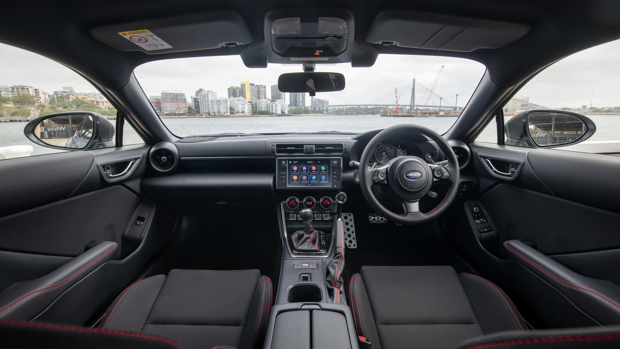
Instead of confusingly small instrument markings, the new BRZ switches to a full-digital cluster with two separate designs – a beautifully clear ‘analogue’ tacho with digital speedo in its centre or, after pressing the ‘Track’ button on the centre console next to the driver, a large bar-graph central tacho with digital speedo below.
In the dash centre there’s a new floating 8.0-inch touchscreen with complementary physical buttons and wired Apple CarPlay/Android Auto that thrusts the BRZ’s UX functionality at least 10 years ahead of where it was. Pity the audio quality isn’t so flash, with six speakers (including dash-mounted tweeters) doing an okay job but never really sounding rich or natural. The fact that it offers multiple settings for Virtual Bass, Dynamic Beat Enhancer, Sound Restorer and Virtual Stage Enhancer technology unfortunately says it all.
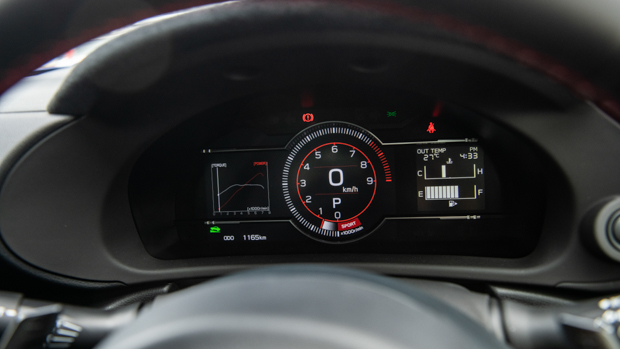
As for overall interior packaging, we only drove the up-spec Coupe S version with its Ultrasuede/vinyl trim combination (compared to cloth in the base car) but trim feel and quality were excellent, supported by loads of red stitching. Each front seat weighs 2.9kg less than before, sits 3.7mm closer to the car’s centre line and the driver’s seat can be adjusted 5mm lower than before.
The rear seat remains as useless as ever for adults (with tilt/slide access only on the left-hand kerb side) but it’s always a saving grace if you want to have your cake and eat it too – breeding without becoming boring. Your kids will thank you when they’re older.
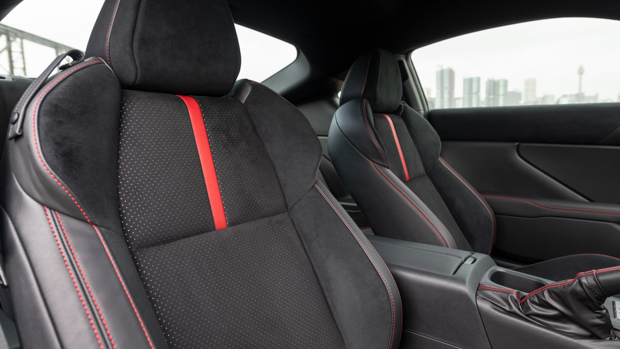
The BRZ’s boot is a modest 201 litres with an upturned full-size alloy spare hogging the space dead-centre, though the rear backrest folds completely flat as a single unit and can now be dropped via pull tabs from the boot area, not just from the buttons inside the cabin.
The official ADR81/02 government combined fuel consumption figure for the BRZ six-speed manual is 9.5L/100km, whereas the six-speed automatic lowers that number to 8.8L/100km. We didn’t get the opportunity to test an individual BRZ’s real-world fuel efficiency but will do so in the coming weeks.

Recommended service intervals for the BRZ are every 12 months or 15,000km, with Subaru’s capped-price servicing plan costing $2390 across five years/75,000km for the manual and $2474 for the automatic.
Subaru Australia’s warranty coverage is five years/unlimited kilometres, in conjunction with 12 months’ roadside assistance.
The danger of a ‘difficult-second-album’ follow-up is that the successor to an original can often lose flavour in its quest to enhance refinement and sophistication, while trying to offer perceived improvement. But the opposite applies here.
The beauty of the second-gen BRZ is that not only does it look better than ever, it also drives better than ever. Carrying over the fundamentals of the previous car but working exhaustively on making sure they operate with greater harmony and improved responsiveness has performed wonders in the new BRZ.
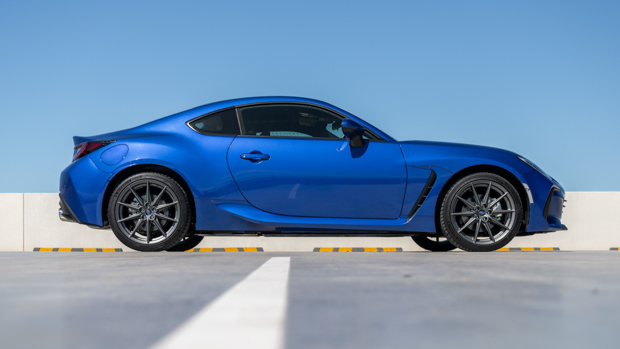
It’s more grown-up and sophisticated in its feel, yet it achieves that while also being more satisfying to drive. And its improvement in performance is tremendous – partly tempered by the fact it doesn’t sound as natural as it should.
As with the previous BRZ, it’s a true sports-car bargain. But given that it starts at $38,990 (before on-road costs) for the Coupe manual and stretches to $43,990 (before on-road costs) for the Coupe S, while offering so much more in terms of all-round ability and equipment, I’d suggest that driving purists chasing genuine value for money have rarely had it better.
Variant tested S
Key specs (as tested)
About Chasing cars
Chasing Cars reviews are 100% independent.
Because we are powered by Budget Direct Insurance, we don’t receive advertising or sales revenue from car manufacturers.
We’re truly independent – giving you Australia’s best car reviews.
The estimate provided does not take into account your personal circumstances but is intended to give a general indication of the cost of insurance, in order to obtain a complete quote, please visit www.budgetdirect.com.au. Estimate includes 15%^ online discount.
^Conditions Apply
Budget Direct Insurance arranged by Auto & General Services Pty Ltd ACN 003 617 909(AGS) AFSL 241 411, for and on behalf of the insurer, Auto & General Insurance Company Limited(ABN 42 111 586 353, AFSL 285 571).Because we don’t know your financial needs, we can’t advise you if this insurance will suit you. You should consider your needs and the Product Disclosure Statement before making a decision to buy insurance. Terms and conditions apply.
Indicative quote based on assumptions including postcode , 40 year old male with no offences, licence suspensions or claims in the last 5 years, a NCD Rating 1 and no younger drivers listed. White car, driven up to 10,000kms a year, unfinanced, with no modifications, factory options and/or non-standard accessories, private use only and garaged at night.
^Online Discounts Terms & Conditions
1. Discounts apply to the premium paid for a new Budget Direct Gold Comprehensive Car Insurance, Third Party Property Only or Third Party Property, Fire & Theft Insurance policy initiated online on or after 29 March 2017. Discounts do not apply to optional Roadside Assistance.
2. Discounts do not apply to any renewal offer of insurance.
3. Discounts only apply to the insurance portion of the premium. Discounts are applied before government charges, taxes, levies and fees, including instalment processing fees (as applicable). The full extent of discounts may therefore be impacted.
4. We reserve the right to change the offer without notice.